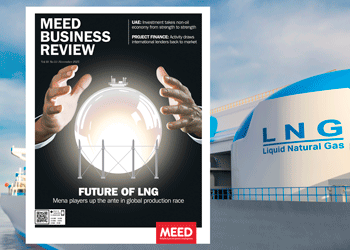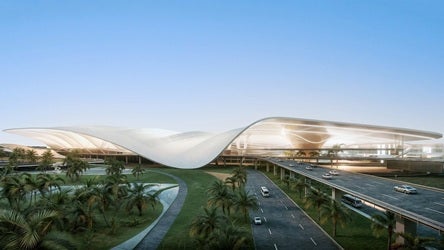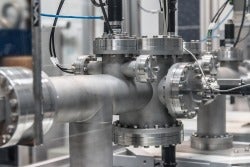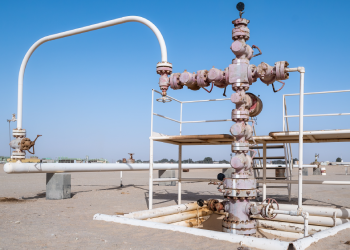PDO awards Budour-Tayseer gas project contract
24 September 2025

Petroleum Development Oman (PDO) has awarded the main contract for a project to build an integrated facility to produce natural gas from the Budour and Tayseer fields in Oman.
The project aims to expand the capacity of the existing gas production and processing facilities at Tayseer. It represents the second development phase of the gas field.
Through the project, PDO is also seeking to appraise, produce and process sweet gas from the Budour field, which is about 50 kilometres west of the Tayseer field.
Kuwait‑based Spetco International Petroleum Company (Spetco) has won the main design, build, own, operate and maintain (DBOOM) contract for the combined Budour-Tayseer sour gas processing facility project, sources say.
MEED recently reported that Spetco was the frontrunner for the DBOOM contract, with PDO expected to issue the official award within days.
The following firms, among others, are understood to have submitted proposals to PDO:
- Enerflex (Canada)
- Jereh Group (China)
- Spetco (Kuwait)
The three developers originally submitted proposals for the project by 30 November last year.
PDO issued the DBOOM tender for the Budour‑Tayseer combined gas processing facility project in Q1 2024, after completing a prequalification exercise in June 2023.
MEED previously reported that PDO suspended the DBOOM tendering exercise earlier this year and tested an alternative execution model, initiating a front‑end engineering and design (feed) to engineering, procurement and construction (EPC) competition.
PDO floated a prequalification document for the feed-to-EPC contest in March. Contractors submitted responses to the prequalification questionnaire by the deadline of 27 April.
The feed-to-EPC competition model involves the project operator selecting contractors to execute feed work and then choosing the contractor with the most competitive feed proposal to execute EPC works on the project, while also compensating the other contestants for their work.
However, PDO did not select contractors to take part in the FEED‑to‑EPC contest and is understood to have cancelled the exercise, sources told MEED. The client eventually reverted to the DBOOM model.
Tayseer and Budour field development
The Tayseer field was discovered in November 2014 after the successful well-testing of Tay-1. It is approximately 50km north of the Birba field and 20km west of the Al-Noor production station.
Since the Tayseer field is part of the A1C platform carbonate, which has proven aquifer support in the Budne A1C field, some formation water production can be expected.
PDO developed the Tayseer field through a project in 2016. US-based Exterran was awarded a design, build and operate contract in 2017.
Currently, three Tayseer wells are being processed in the existing Tayseer early development facility and sweet gas from the facility is being exported to PDO’s South Oman gas pipeline.
As part of the expansion phase, new production wells will be drilled at Tayseer. The produced gas will be processed at a new sour gas processing facility located at Budour.
The Budour A4C non-associated gas field was discovered in 2001 and appraised until 2009. The field has never been appraised since. The development concept for the Budour non-associated gas field involves depletion through a standalone sour gas processing facility, with sweet gas exported to the South Oman gas pipeline.
No formation water is expected, so only the condensation water requires handling and disposal. New production wells are to be drilled at Budour and production from those wells will be processed at the planned new sour gas processing facility.
The DBOOM contractor was required to provide the following on-plot facilities and services as part of the project:
- Inlet production/ test manifold
- Well testing
- Inlet separation
- Sour gas processing facility, including export gas compressors
- Sulphur recovery and storage
- Crude de-salting
- Condensate stabilisation
- Condensate storage and export
- Produced water treatment
- Storage, export and raw water treatment with all the associated plant utilities
- Controls and instrumentation
The planned combined Budour-Tayseer sour gas processing facility is projected to have a capacity of 78.39 million cubic feet a day (cf/d) and unstabilised condensate of 1,167 cubic metres a day (cm/d). The facility will handle gas exports of about 70 million cf/d, stabilised condensate exports of 950 cm/d and will have a water handling capacity of 340 cm/d.
Outside the scope of services under the original DBOOM contract, PDO intended to build off-plot facilities to support the Budour-Tayseer combined gas processing facility. These were:
- Wellhead hook-ups
- Sour gas flowlines from the wellhead to the on-plot facilities
- Remote manifold station at the Tayseer field
- Wash water distribution network from the on-plot facility boundaries to gas production wellheads
- Sour gas production pipeline from the Tayseer field to the Budour field
- Sweet gas export pipeline from the on-plot facility to the Salalah gas line
- Condensate export pipeline from the on-plot facility to the main oil line
- Produced water pipeline from the on-plot facility to the Marmul water treatment plant in southeastern Oman for further processing and deep water disposal
- Raw water supply line from the water supply well to the on-plot facility and electrical overhead line from the PDO grid to the DBOOM facility.
ALSO READ: Oman makes strides forward in global LNG race
Exclusive from Meed
-
 Dubai extends bid deadlines for key drainage projects
Dubai extends bid deadlines for key drainage projects31 October 2025
-
 Gas demand reshapes priorities
Gas demand reshapes priorities31 October 2025
-
 Dubai evaluates Al-Maktoum airport substructure bids
Dubai evaluates Al-Maktoum airport substructure bids31 October 2025
-
 Financial close reached for Jubail-Buraydah link
Financial close reached for Jubail-Buraydah link31 October 2025
-
 Libya oil project expected to progress despite Petrofac collapse
Libya oil project expected to progress despite Petrofac collapse31 October 2025
All of this is only 1% of what MEED.com has to offer
Subscribe now and unlock all the 153,671 articles on MEED.com
- All the latest news, data, and market intelligence across MENA at your fingerprints
- First-hand updates and inside information on projects, clients and competitors that matter to you
- 20 years' archive of information, data, and news for you to access at your convenience
- Strategize to succeed and minimise risks with timely analysis of current and future market trends

Related Articles
-
 Dubai extends bid deadlines for key drainage projects
Dubai extends bid deadlines for key drainage projects31 October 2025
Dubai Municipality has extended the bid submission deadlines for two key drainage projects under the $8bn Tasreef programme to develop, rehabilitate and expand Dubai’s stormwater drainage network.
The first project, listed as TF-05-C1, involves a stormwater drainage system in Jebel Ali and the surrounding areas.
The new deadline is 10 November, a source close to the project told MEED.
The project covers approximately 27 kilometres of stormwater network and will serve major transport routes, including Sheikh Zayed Road and Al-Jamayel Road.
The bid submission date for the tender, was initially 2 October before being extended to 30 October.
The second project, listed under TF-11-C1, is for the development of a stormwater pond, evacuation line and pumping station.
The project includes a comprehensive stormwater drainage system, featuring a tunnel ranging from three to four metres in diameter along Dubai–Al Ain Road and the D54.
The new deadline is 4 November.
The bid submission date for the tender, was initially 25 September.
The schemes are being procured by the municipality’s Sewerage and Recycled Water Projects Department as part of the Tasreef programme.
In October, Dubai Municipality awarded contracts for two other major projects under the initiative.
Local firm DeTech Contracting won the main contract for the construction of a stormwater drainage system on Sheikh Mohammed Bin Zayed Road and Al-Yalayis Road in Dubai.
The municipality alos awarded a contract to Greece/Lebanon-based Archirodon for the construction of the Resilient Future Flow Outfall project.
The $25m project involves the construction of a 4-kilometre subsea pipeline with a 2-metre diameter and a discharge capacity of 9 cubic metres a second.
The Tasreef masterplan that will serve key areas across the emirate, including Nad Al-Hamar, the vicinity of Dubai International airport, Garhoud, Rashidiya, Al-Quoz, Zabeel, Al-Wasl, Jumeirah and Al-Badaa. The initiative aims to expand Dubai’s rainwater drainage capacity by 700% by 2033.
DeTech Consulting previously won the $136m contract to upgrade the West Deira stormwater system.
This project was the first of the five planned Tasreef projects to enter construction, earlier this year.
https://image.digitalinsightresearch.in/uploads/NewsArticle/14993856/main.jpg -
 Gas demand reshapes priorities
Gas demand reshapes priorities31 October 2025
 Commentary
Commentary
Colin Foreman
EditorRead the November issue of MEED Business Review
Gas has increasingly been regarded as a crucial transition fuel over the past decade as governments race to cut carbon emissions and meet climate pledges – including the Paris Agreement’s aim to keep warming well below 2°C and pursue efforts to limit it to 1.5°C.
 Those commitments have driven the demand for liquefied natural gas (LNG) globally and this has reshaped investment priorities across the region, with Qatar, Oman and the UAE eyeing future export growth.
Those commitments have driven the demand for liquefied natural gas (LNG) globally and this has reshaped investment priorities across the region, with Qatar, Oman and the UAE eyeing future export growth.QatarEnergy’s North Field expansion is the largest investment. The estimated $40bn programme will push Qatar’s LNG output towards 142 million tonnes a year by the end of this decade, almost doubling its present position and consolidating its role as a market anchor.
Abu Dhabi is also committed to expanding its capacity. Its downstream strategies include a major greenfield LNG terminal at Ruwais, due to enter service in 2028 with two 4.8 million t/y trains adding 9.6 million t/y to the UAE’s export capability.
These programmes are keeping contractors busy. Over the past five years, more than $44bn of LNG-related contracts have been awarded in the region – which is more than eight times the $5.3bn recorded in the previous five year period.
At the same time, there are ample opportunities for contractors as other countries in the region build import infrastructure. Projects are already under way in Kuwait, Iraq, Jordan, Egypt, Algeria and Morocco – and more are expected.
With base load concerns remaining for many countries when it comes to completely switching to renewables, gas is expected to be a fuel of choice for the decades to come. The investments made in production capacity mean the region will play a pivotal role in delivering the world’s energy needs.
 READ THE NOVEMBER 2025 MEED BUSINESS REVIEW – click here to view PDF
READ THE NOVEMBER 2025 MEED BUSINESS REVIEW – click here to view PDFMena players up the ante in global LNG production race; Investment takes UAE non-oil economy from strength to strength; Project finance activity draws international lenders back to market
Distributed to senior decision-makers in the region and around the world, the November 2025 edition of MEED Business Review includes:
> AGENDA 1: Gulf LNG sector enters a new prolific phase> INDUSTRY REPORT 1: Region sees evolving project finance demand> INDUSTRY REPORT 2: Iraq leads non-GCC project finance activity> GREEN STEEL: Abu Dhabi takes the lead in green steel transition> DIGITISATION: Riyadh-based organisation drives digital growth> UAE MARKET FOCUS: Investment shapes UAE growth storyTo see previous issues of MEED Business Review, please click herehttps://image.digitalinsightresearch.in/uploads/NewsArticle/14992876/main.gif -
 Dubai evaluates Al-Maktoum airport substructure bids
Dubai evaluates Al-Maktoum airport substructure bids31 October 2025

Dubai Aviation Engineering Projects (DAEP) is evaluating the bids it received from contractors on 15 September for substructure works for the first phase of the expansion of Al-Maktoum International airport.
“The bid evaluation is ongoing and the project is expected to be awarded by the end of this year,” sources close to the project told MEED.
MEED understands that the bidders include:
- Alec (local)
- China Civil Engineering Construction Corporation (China)
- China State Construction Engineering Corporation (China)
- China Harbour Engineering Company (China)
- Dutco Construction (local)
- Innovo (local)
- Limak / PowerChina (Turkiye/China)
- Shapoorji Pallonji (India)
- Webuild / Tristar (Italy/local)
According to an official description on DAEP’s website, the expanded airport’s West Terminal will be a seven-level, 800,000-square-metre facility with an annual capacity of 45 million passengers.
It will be the second of three terminals at Al-Maktoum International airport, linked to the airside by a 14-station automated people-mover (APM) system.
In August, MEED exclusively reported that DAEP had received bids from firms to build the APM at Al-Maktoum airport.
The system will run under the apron of the entire airfield and the airport’s terminals. It will consist of several tracks, taking passengers from the terminals to the concourses.
Four underground stations will be built as part of the first phase. The overall plan includes 14 stations across the airport.
The airport’s construction is planned to be undertaken in three phases. The airport will cover an area of 70 square kilometres (sq km) south of Dubai and will have five parallel runways, five terminal buildings and 400 aircraft gates.
It will be five times the size of the existing Dubai International airport and will have the world’s largest passenger-handling capacity of 260 million passengers a year. For cargo, it will have the capacity to handle 12 million tonnes a year.
Construction progress
Construction on the first phase has already begun. In May, MEED exclusively reported that DAEP had awarded a AED1bn ($272m) deal to UAE firm Binladin Contracting Group to construct the second runway at the airport.
The enabling works on the terminal are also ongoing and are being undertaken by Abu Dhabi-based Tristar E&C.
While speaking to the press on the sidelines of the Airport Show in Dubai in May, Khalifa Al-Zaffin, executive chairman of Dubai Aviation City Corporation, said the government of Dubai will award more packages this year, including for the APM and baggage handling systems.
“Several other packages are expected to be tendered this year, including the terminal substructure, 132kV substations and district cooling plants,” Al-Zaffin said.
Construction works on the project’s first phase are expected to be completed by 2032.
The government approved the updated designs and timelines for its largest construction project in April 2024.
In a statement, the authorities said the plan is for all operations from Dubai International airport to be transferred to Al-Maktoum International within 10 years.
The statement added that the project will create housing demand for 1 million people around the airport.
In September last year, MEED exclusively reported that a team comprising Austria’s Coop Himmelb(l)au and Lebanon’s Dar Al-Handasah had been confirmed as the lead masterplanning and design consultants on the expansion of Al-Maktoum airport.
Project history
The expansion of Al-Maktoum International, also known as Dubai World Central (DWC), is a long-standing project. It was officially launched in 2014, with a different design from the one approved in April 2024. At that time, it involved building the biggest airport in the world by 2050, with the capacity to handle 255 million passengers a year.
An initial phase, due to be completed in 2030, involved increasing the airport’s capacity to 130 million passengers a year. The development was to cover an area of 56 sq km.
Progress on the project slipped as the region grappled with the impact of lower oil prices and Dubai focused on developing the Expo 2020 site. Tendering for work on the project then stalled with the onset of the Covid-19 pandemic in early 2020.
 READ THE NOVEMBER 2025 MEED BUSINESS REVIEW – click here to view PDF
READ THE NOVEMBER 2025 MEED BUSINESS REVIEW – click here to view PDFMena players up the ante in global LNG production race; Investment takes UAE non-oil economy from strength to strength; Project finance activity draws international lenders back to market
Distributed to senior decision-makers in the region and around the world, the November 2025 edition of MEED Business Review includes:
> AGENDA 1: Gulf LNG sector enters a new prolific phase> INDUSTRY REPORT 1: Region sees evolving project finance demand> INDUSTRY REPORT 2: Iraq leads non-GCC project finance activity> GREEN STEEL: Abu Dhabi takes the lead in green steel transition> DIGITISATION: Riyadh-based organisation drives digital growth> UAE MARKET FOCUS: Investment shapes UAE growth storyTo see previous issues of MEED Business Review, please click herehttps://image.digitalinsightresearch.in/uploads/NewsArticle/14991651/main.jpg -
 Financial close reached for Jubail-Buraydah link
Financial close reached for Jubail-Buraydah link31 October 2025
Register for MEED’s 14-day trial access
Saudi Water Partnership Company (SWPC) has announced financial close for the Jubail-Buraydah independent water transmission pipeline (IWTP) project.
Saudi Arabia’s second IWTP project will link Jubail in the kingdom’s Eastern Province and Buraydah in the Qassim region via a 587-kilometre (km) pipeline that can transmit 650,000 cubic metres a day (cm/d) of water.
It will have a potable water storage capacity of 1.63 million cubic metres.
The project will have a total cost of SR8.5bn ($2.2bn).
A developer team comprising local companies Aljomaih Energy & Water, Nesma Company and Buhur for Investment Company was named as the preferred bidder for the contract last year.
The Aljomaih, Nesma and Buhur team had proposed to develop the project for SR3.59468 a cubic metre.
SWPC signed a contract agreement to develop and operate the Jubail-Buraydah IWTP project in May.
The project is being developed under a build-own-operate-transfer model with a 35-year concession period from the project’s commercial operation date.
Local content is expected to reach 45% during the construction phase and 70% during operations.
Commercial operation is scheduled for the first quarter of 2029.
 READ THE NOVEMBER 2025 MEED BUSINESS REVIEW – click here to view PDF
READ THE NOVEMBER 2025 MEED BUSINESS REVIEW – click here to view PDFMena players up the ante in global LNG production race; Investment takes UAE non-oil economy from strength to strength; Project finance activity draws international lenders back to market
Distributed to senior decision-makers in the region and around the world, the November 2025 edition of MEED Business Review includes:
> AGENDA 1: Gulf LNG sector enters a new prolific phase> INDUSTRY REPORT 1: Region sees evolving project finance demand> INDUSTRY REPORT 2: Iraq leads non-GCC project finance activity> GREEN STEEL: Abu Dhabi takes the lead in green steel transition> DIGITISATION: Riyadh-based organisation drives digital growth> UAE MARKET FOCUS: Investment shapes UAE growth storyTo see previous issues of MEED Business Review, please click herehttps://image.digitalinsightresearch.in/uploads/NewsArticle/14991282/main.jpg -
 Libya oil project expected to progress despite Petrofac collapse
Libya oil project expected to progress despite Petrofac collapse31 October 2025

Register for MEED’s 14-day trial access
The tender process for Libya’s 6J North Gialo oil field development project is expected to progress following Petrofac’s announcement that it has gone into administration, according to industry sources.
UK-based Petrofac is one of just two companies that submitted bids for the project. The other is Egypt-based Petrojet.
In September, MEED revealed that the bids had been submitted for the project and were under evaluation.
The client on the project is Libya’s Waha Oil Company and Petrofac completed the front-end engineering and design (feed) for the project in 2020.
Waha is a joint venture of Libya’s National Oil Corporation (NOC), France’s TotalEnergies and US-based ConocoPhillips.
Commenting on the impact of Petrofac’s insolvency, one industry source said: “This has definitely increased uncertainty for the project.
“It could potentially mean that this contract is retendered, but there is a lot of confidence that this tender will still go ahead in some form.
“Waha Oil and Libya’s NOC have made it clear that this project is a priority and they want it to go ahead.
“Progress is still expected on this tender, but it is possible that there will be more delays before this contract is awarded and signed.”
The 6J North Gialo field development project is part of a series of tenders that are collectively expected to be worth $1bn.
The three projects are:
- NC98
- Gialo 3
- 6J North Gialo
All three projects will develop Libyan reservoirs that have not yet been tapped.
The 6J North Gialo project was the first to be tendered and it is expected to be followed by NC98, with the Gialo 3 project likely to be tendered last.
Together, the projects are expected to double Waha’s production from about 300,000 barrels a day (b/d) of oil to 600,000 b/d. The Waha concession covers 13 million acres.
https://image.digitalinsightresearch.in/uploads/NewsArticle/14990491/main.png


